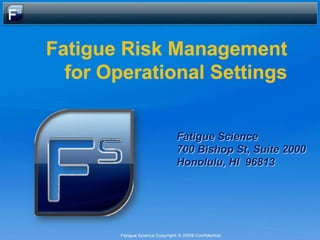
Fatigue Science Risk Management
- 1. Fatigue Science 700 Bishop St, Suite 2000 Honolulu, HI 96813
- 2. Fatigue is a Serious Concern Expert consensus is that fatigue is “the largest identifiable and preventable cause of accidents in transport operations…” Cited in a 2003 report, one safety study indicates fatigue may contribute to 20-40% of commercial transport accidents. Other reports suggest that 21% of aviation incidents, 16% of marine vessel casualties, and 31% of fatal truck accidents are fatigue related.
- 3. Fatigue Factors Operator fatigue is a function of the sleep quality/quantity and the body clock. Sleep Circadian Restriction FATIGUE Factors
- 4. Blood-Alcohol/Fatigue Comparison The effects of fatigue may be compared to the effects of blood alcohol levels Continuous Hours Blood Alcohol Concentration Awake (no sleep debt) (BAC) 18.5 0.05 (significantly impaired) 21 0.08 (illegal to drive in Canada) 2 - 3 Drinks in 1 Hour IMPAIRED 4 - 5 DRINKS = BAC 0.08 or 21 Hours Continuously Awake
- 5. People Often Restrict Their Sleep = Sleep Debt Day-after-day of sleep restriction often is a bigger problem than long periods of continuous wakefulness Vigilance Task Performance 25 3 Hours Sleep 5 Hours Sleep 7 Hours Sleep Mean # of Lapses 20 9 Hours Sleep 15 10 5 0 0 1 2 3 4 5 6 7 8 9 10 11 12 13 14 Baseline Experimental Recovery Day Johnson et a. (2004). Modulating the homeostatic process to predict performance during chronic sleep restriction. Aviation, Space and Environmental Medicine, 75(3 Suppl):A141-6.
- 6. Sleep Restriction, Effectiveness, & BAC After five nights of partial sleep deprivation, three drinks will have the same effect on your body as six would when you've slept enough. National Sleep Foundation , 4/17/2009
- 7. Self-judgments of Fatigue Aren't Accurate Actual Sleepiness/Fatigue Self-Rated Sleepiness/Fatigue 4.0 Stanford Sleepiness Scale 20 4 hr sleep 6 hr sleep Stanford Sleepiness Scale score 3.0 8 hr sleep Vigilance Lapses 15 PVT lapses 10 2.0 5 1.0 0 0.0 -5 -1.0 BL 2 4 6 8 10 12 14 BL 2 4 6 8 10 12 14 DaysDaysSleep restriction of of sleep Restriction DaysDaysSleep restriction of of sleep Restriction Objective measures show Self ratings of fatigue fail to fatigue progressively degrades BUT recognize all but the initial cognitive performance fatigue effects! Van Dongen, Maislin, Mullington, and Dinges (2003)
- 8. The Objective Fatigue Science Approach Scientific Research shows that it is not possible for people to accurately assess their own level of fatigue. We can predict fatigue based on sleep quality and quantity by using our Sleep Bands and validated software. Accident Risk can be predicted based on the levels of fatigue.
- 9. How Data Is Collected and Processed Wear the SleepBand for 7 days • Lightweight • Waterproof • Unobtrusive Data is processed and fatigue /accident risk is determined by the US Dept. of Transportation validated SAFTE model.
- 10. Accident Risk Level Management Reports Once the data has been analyzed the employer receives a summary Fatigue Accident Risk Report Reports show where in the organization the fatigue risk is and the levels of fatigue/accident risk For example, the reports can tell which shifts, locations, job type, etc. are responsible for any increased Accident Risk.
- 11. SleepBand Group Summary Data Calculate group statistics
- 12. Reducing Accident Risk Once the causes of the Accident Risk have been identified mitigation strategies are designed to reduce the risk. Once the strategies have been implemented (usually 30-60 days) we have the workers wear the Sleep Bands a second time to make sure the Accident Risk has been reduced.
- 13. Fatigue Mitigation Design/conduct mitigation strategy Workshops/Classes Printed Guides
- 14. Summary of the Process 1st Obtain the baseline for organizational fatigue accident risk 2nd Once the sources and causes of accident risk have been indentified a mitigation strategy is designed to reduce risk that includes: worker training, schedule analysis, education. 3rd Re-access the fatigue accident risk in 30 to 60 days to determine the effectiveness of the mitigation steps and set new priorities
- 16. For Additional Information Contact: John.caldwell@fatiguescience.com Fatigue Science 700 Bishop St, Suite 2000 Honolulu, HI 96813
Editor's Notes
- This graph is from a study conducted at the Walter Reed Army Institute for Research. The data being graphed is the number of lapses (or failures to respond) on a vigilance task that measures sustained attention. This task is relevant to many modern jobs that require personnel to monitor systems while computers do the work. Essentially, the human is there as a backup. If vigilance/attention is impaired by something, it is more likely that warning lights, developing system problems, or other difficulties will be accidentally overlooked. On the first 3 days, people were allowed to sleep 9 hours per day. During the next 7 days, 3 groups were sleep restricted to either 7, 5, or 3 hours per night. On the last 3 days, people were allowed to secure 9 hours of recovery sleep each day.Five points to note:The group that got only 3 h per day is significantly impaired very early.However, even the 7 h group is showing a gradual deterioration throughout.Despite 3 recovery days, none of the groups returns to baseline performance.The consistent lapse increases in the restricted groups show that people are not getting used to the sleep restriction despite 7 days of trying.The insufficient recovery shows that people take much longer than was once thought to recover from chronic sleep loss (i.e., a weekend off won’t do the trick).